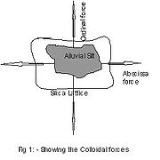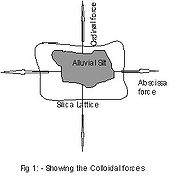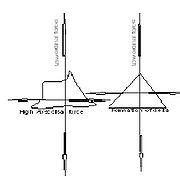
Formation of delta-shaped river basin
Encyclopedia
The formation of a river basin at the mouth of the river
is usually characterised by the shape of a delta
, the triangular Greek letter
. The cause of this shape of the river basin may be explained by the theory of colloid
s.

 The river basin does form due to the formation of bottom-set beds, consisting of finer materials carried farthest seaward and laid down on the floor of the embayment, on which the delta is formed. Fore-set beds are somewhat coarser and they represent the advancing front of the delta and the greater part of its bulk. They usually have a distinctly steeper dip than the bottom-set beds and are in reality a continuation of the alluvial plain
The river basin does form due to the formation of bottom-set beds, consisting of finer materials carried farthest seaward and laid down on the floor of the embayment, on which the delta is formed. Fore-set beds are somewhat coarser and they represent the advancing front of the delta and the greater part of its bulk. They usually have a distinctly steeper dip than the bottom-set beds and are in reality a continuation of the alluvial plain
of which the delta is the terminal position.
s are such substances, which basically possess an outward force
which expands in two ways: -
1. Ordinal (vertical pressure)
2. Abscissal
(horizontal)
The lattice spread around those particles controls these forces. In the ordinal force the pressure
is maximum at the two apexes
of the particle. In the case of abscissal pressure, the maximum pressure is at the vertex
which depends upon the lattice.(fig 1) In the formation of delta-shaped river basin, the abscissal pressure is much more than the ordinal pressure(fig 2)
Therefore the delta shaped river basin is produced.
Colloids are present in the river system due to the presence of suspended alluvial silt
as well as silica deposits from the seawater
, which act as the lattice for the colloidal bed.
in Lake St. Clair
has the classic shape of the delta (see fig 3)
River
A river is a natural watercourse, usually freshwater, flowing towards an ocean, a lake, a sea, or another river. In a few cases, a river simply flows into the ground or dries up completely before reaching another body of water. Small rivers may also be called by several other names, including...
is usually characterised by the shape of a delta
River delta
A delta is a landform that is formed at the mouth of a river where that river flows into an ocean, sea, estuary, lake, reservoir, flat arid area, or another river. Deltas are formed from the deposition of the sediment carried by the river as the flow leaves the mouth of the river...
, the triangular Greek letter
Delta (letter)
Delta is the fourth letter of the Greek alphabet. In the system of Greek numerals it has a value of 4. It was derived from the Phoenician letter Dalet...
. The cause of this shape of the river basin may be explained by the theory of colloid
Colloid
A colloid is a substance microscopically dispersed evenly throughout another substance.A colloidal system consists of two separate phases: a dispersed phase and a continuous phase . A colloidal system may be solid, liquid, or gaseous.Many familiar substances are colloids, as shown in the chart below...
s.
Introduction


Alluvial plain
An alluvial plain is a relatively flat landform created by the deposition of sediment over a long period of time by one or more rivers coming from highland regions, from which alluvial soil forms...
of which the delta is the terminal position.
Application of Colloidal theory to delta–shaped river basins
ColloidColloid
A colloid is a substance microscopically dispersed evenly throughout another substance.A colloidal system consists of two separate phases: a dispersed phase and a continuous phase . A colloidal system may be solid, liquid, or gaseous.Many familiar substances are colloids, as shown in the chart below...
s are such substances, which basically possess an outward force
Force
In physics, a force is any influence that causes an object to undergo a change in speed, a change in direction, or a change in shape. In other words, a force is that which can cause an object with mass to change its velocity , i.e., to accelerate, or which can cause a flexible object to deform...
which expands in two ways: -
1. Ordinal (vertical pressure)
2. Abscissal
Abscission
Abscission is a term used in several areas of biology. In plant sciences it most commonly refers to the process by which a plant drops one or more of its parts, such as a leaf, fruit, flower or seed...
(horizontal)
The lattice spread around those particles controls these forces. In the ordinal force the pressure
Pressure
Pressure is the force per unit area applied in a direction perpendicular to the surface of an object. Gauge pressure is the pressure relative to the local atmospheric or ambient pressure.- Definition :...
is maximum at the two apexes
Apex (geometry)
In geometry, an apex is the vertex which is in some sense the highest of the figure to which it belongs.*In an isosceles triangle, the apex is the vertex where the two sides of equal length meet, opposite the unequal third side....
of the particle. In the case of abscissal pressure, the maximum pressure is at the vertex
Vertex (geometry)
In geometry, a vertex is a special kind of point that describes the corners or intersections of geometric shapes.-Of an angle:...
which depends upon the lattice.(fig 1) In the formation of delta-shaped river basin, the abscissal pressure is much more than the ordinal pressure(fig 2)
Therefore the delta shaped river basin is produced.
Colloids are present in the river system due to the presence of suspended alluvial silt
Silt
Silt is granular material of a size somewhere between sand and clay whose mineral origin is quartz and feldspar. Silt may occur as a soil or as suspended sediment in a surface water body...
as well as silica deposits from the seawater
Seawater
Seawater is water from a sea or ocean. On average, seawater in the world's oceans has a salinity of about 3.5% . This means that every kilogram of seawater has approximately of dissolved salts . The average density of seawater at the ocean surface is 1.025 g/ml...
, which act as the lattice for the colloidal bed.
Examples of delta shaped river basins
The Delta (shaded area) of the St. Clair RiverSt. Clair River
The St. Clair River is a river in central North America which drains Lake Huron into Lake St Clair, forming part of the international boundary between the Canadian province of Ontario and the U.S. state of Michigan...
in Lake St. Clair
Lake Saint Clair (North America)
Lake St. Clair is a fresh-water lake named after Clare of Assisi that lies between the Province of Ontario and the State of Michigan, and its midline also forms the boundary between Canada and the United States of America. Lake St. Clair includes the Anchor Bay along the Metro Detroit coastline...
has the classic shape of the delta (see fig 3)

